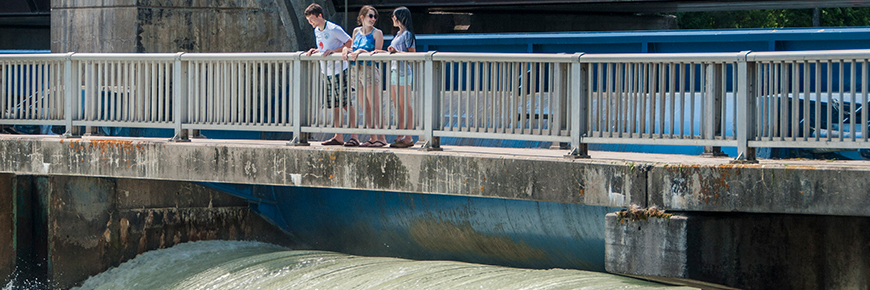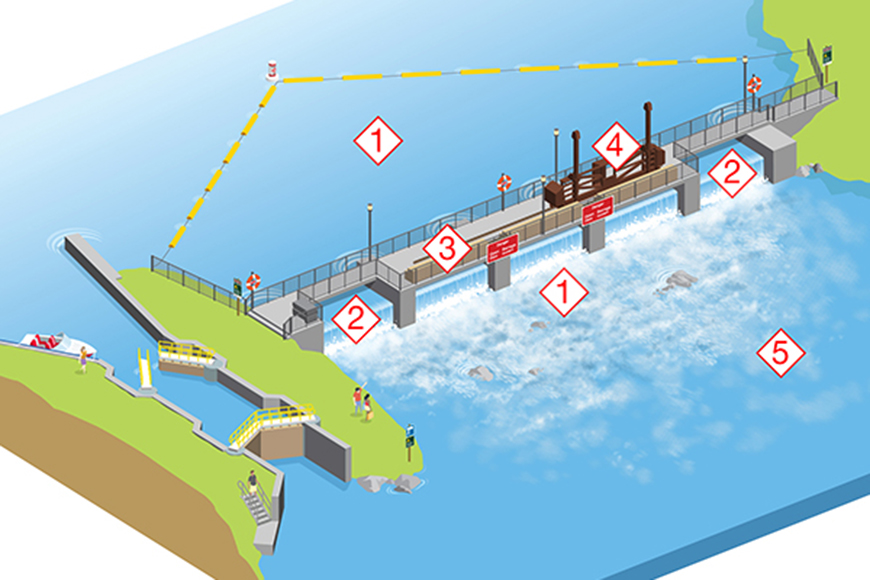
Dams: How to stay safe
Trent-Severn Waterway National Historic Site
What are dams?
Dams are structures that hold back water.
They can be built from different materials but are most commonly made out of concrete, steel, timber, or earth.
Why do people build dams?
Dams help control the flow of water in waterways. Many lakes are formed by dams. They can help control floods and provide hydroelectric power, a renewable energy source. On historic canals, dams support navigation by controlling water levels.
What to be aware of when visiting a dam
Getting too close to dams can be dangerous. Calm water can quickly, and without warning, become a surge of fast-moving water. This fast-moving water creates strong undercurrents that cannot always be seen from the surface and can drown even the strongest swimmer.
Signs, fences, buoys, and safety booms are there to warn you of dam hazards.
Hazard definitions

1 - Strong Currents and Undertow
Strong currents and undertow can cause anyone who enters the water near a dam to be washed downstream, through the structure, or become pinned against the structure and unable to escape.
Getting caught in an undertow or strong current can result in drowning or other fatal injuries. Steep shorelines near some dams may make self-rescue very difficult.
2 - Falling
At overflow spillways, it can be difficult to see the vertical drop that may occur at the outflow of a dam. Being washed through a dam or falling from the structure could lead to significant injuries that could even be fatal.
3 - Tripping Hazards
Tripping hazards are often located on a dam deck, but may also occur in the natural environment near a dam. Hazards such as crane rail tracks also pose a risk to cyclists or motorcyclists when dams are used as a roadway.
Look for hazards on walking surfaces or roadways when traveling across or near a dam.
4 - Operational Equipment
Operational equipment such as manual winches, log lifters, or stop logs, whether during staff operations or unauthorized use, can lead to minor or major injuries. Visitors should stay clear of operational equipment. Unauthorized use could pose a public safety risk.
5 - Rapid changes in water flow and/or level
Water levels and flow change quickly near a dam. Increased water flow can cause normally dry areas to pool water, which could result in a person being stranded without an escape route or swept into strong currents.
If water levels begin to change near a dam, back away from the dam immediately.
Dam safety tips:
- Follow all signs, fences, booms, buoys and barriers at dams and along their surrounding shorelines. These are put in place to protect you.
- Stay back from the edge of the water near dams. If you see water levels changing, move away from the dam immediately.
- Never stand, fish, or anchor your boat below a dam. Water levels change quickly and can swamp your boat or pull you into an undertow.
- Do not swim near dams or in areas with a strong current.
- Never paddle near dams.
- Don’t wade into moving water.
- Avoid hiking too close to dams. Water levels can rise rapidly if the dam is opened or the weather changes.
- Stay off of ice around dams. Ice is always thinner around the dams and changing water levels can make ice unstable.
Related links
- Date modified :